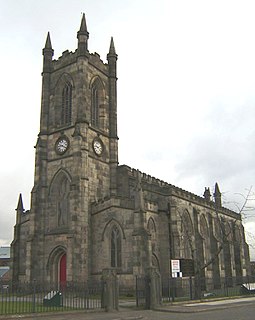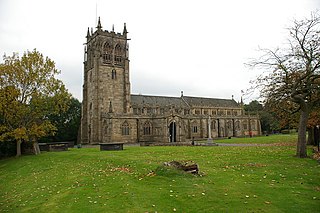
Manchester is the most-populous city and metropolitan borough in North West England and Greater Manchester, England. The city has the country's fifth-largest population at 547,627, lying within the United Kingdom's second-most populous urban area with a population of 2.7 million and the third most-populous county at around 2.8 million. It is fringed by the Cheshire Plain to the south, the Pennines to the north and east. The city is surrounded by outlying towns and the neighbouring city of Salford. These two cities and the surrounding towns form a large continuous conurbation. The local authority for the city is Manchester City Council.

Lancashire is a county in North West England. Lancashire is a historic, ceremonial and non-metropolitan county and the county boundaries differ between these different forms. Its county town is Lancaster. The non-metropolitan county was created by the Local Government Act 1972 and is administered by the Lancashire County Council and twelve district councils. Its administrative centre is Preston. The ceremonial county also includes the districts of Blackpool and Blackburn with Darwen, with a population of 1,449,300 and an area of 1,189 square miles (3,080 km2).

Greater Manchester is a metropolitan county and combined authority area in North West England, with a population of 2.8 million; comprising ten metropolitan boroughs: Manchester, Salford, Bolton, Bury, Oldham, Rochdale, Stockport, Tameside, Trafford and Wigan. The county was created on 1 April 1974, as a result of the Local Government Act 1972, and designated a functional city region on 1 April 2011. Greater Manchester is formed of parts of the historic counties of Lancashire, Cheshire and the West Riding of Yorkshire.

Failsworth is a town in the Metropolitan Borough of Oldham in Greater Manchester, England, 3.7 miles (6.0 km) north-east of Manchester city centre and 2.9 miles (4.7 km) south-west of Oldham. The orbital M60 motorway skirts it to the east. The population at the 2011 census was 20,680. Historically in Lancashire, Failsworth until the 19th century was a farming township linked ecclesiastically with Manchester. Inhabitants supplemented their farming income with domestic hand-loom weaving. The humid climate and abundant labour and coal led to weaving of textiles as a Lancashire Mill Town with redbrick cotton mills. A current landmark is the Failsworth Pole. Daisy Nook is a country park on the southern edge.

The City of Salford is a metropolitan borough with the status of a city in Greater Manchester, England. The borough is named after its main settlement, Salford. The borough covers the towns of Eccles, Swinton, Walkden and Pendlebury. As well as the villages and suburbs of Monton, Little Hulton, Boothstown, Ellenbrook, Clifton, Cadishead, Pendleton, Winton and Worsley. The city has a population of 245,600, and is administered from the Salford Civic Centre in Swinton. Salford is the historic centre of the Salford Hundred which was never formally ceased as a division of Lancashire.

Cheadle Hulme is a suburb in the Metropolitan Borough of Stockport, Greater Manchester, England,. Historically in the county of Cheshire, Cheadle Hulme is 2.3 miles (3.7 km) south-west of Stockport and 7.5 miles (12.1 km) south-east of Manchester. It lies in the Ladybrook Valley, on the Cheshire Plain, and the drift consists mostly of boulder clay, sands and gravels. In 2011, it had a population of 26,479.

Worsley is a village in the City of Salford in Greater Manchester, England, which in 2014 had a population of 10,090. It lies along Worsley Brook, 5.75 miles (9.25 km) west of Manchester.

Middleton is a town in the Metropolitan Borough of Rochdale, Greater Manchester, England, on the River Irk 5 miles (8.0 km) southwest of Rochdale and 5 miles (8.0 km) northeast of Manchester city centre. Middleton had a population of 42,972 at the 2011 Census. It lies on the northern edge of Manchester, with Blackley to the south and Moston to the south east.

Orrell is a ward of the Metropolitan Borough of Wigan, Greater Manchester, England. The population of the ward had fallen at the 2011 Census to 11,513. The centre of the area lies 3 miles (4.8 km) to the west of Wigan town centre and serves as a predominantly residential suburb of Wigan. The area is contiguous with the district of Pemberton.

Eccles is a town in the City of Salford in Greater Manchester, England. Eccles is 2.7 miles (4.3 km) west of Salford and 3.7 miles (6.0 km) west of Manchester, split by the M602 motorway and bordered by the Manchester Ship Canal to the south. The town is famous for the Eccles cake.

Blackrod is a town and civil parish in the Metropolitan Borough of Bolton, Greater Manchester, England, 3.9 miles (6.3 km) northeast of Wigan and 6.6 miles (10.6 km) west of Bolton. At the United Kingdom Census 2011, it had a population of 5,001.

The Association of Greater Manchester Authorities (AGMA) is the local government association for Greater Manchester, a metropolitan county in North West England. It was established in 1986 as a voluntary organisation to represent the ten district councils of Greater Manchester after the Greater Manchester County Council was abolished. AGMA develops policy, lobbies government and others, and runs a range of services designed to make strategic and tangible advances in the standard of living across Greater Manchester. Its Policy and Research Unit is based in Wigan,

Pendleton is a suburb and district of Salford, in the City of Salford, Greater Manchester, England, located 2 miles (3.2 km) from Manchester. The A6 dual carriageway skirts the east of the district. Historically in Lancashire, Pendleton experienced rapid urbanisation during the Industrial Revolution.
Bardsley is a suburban area of Oldham, in Greater Manchester, England.
William Hulme was an English lawyer and landowner from Lancashire responsible for the creation of the Hulme Trust.

Rochdale was an ecclesiastical parish of early-medieval origin in northern England, administered from the Church of St Chad, Rochdale. At its zenith, it occupied 58,620 acres (237 km2) of land amongst the South Pennines, and straddled the historic county boundary between Lancashire and the West Riding of Yorkshire. To the north and north-west was the parish of Whalley; to the southwest was the parish of Bury; to the south was Middleton and Prestwich-cum-Oldham.
The Office of High Sheriff of Greater Manchester is the ceremonial position of High Sheriff appointed to Greater Manchester, a metropolitan county in North West England. The appointment is made by the British monarch, in their capacity as Duke of Lancaster, by pricking the Lites. Created in 1974, the High Sheriff of Greater Manchester has the duty to "protect and assist in upholding the dignity and well being of Her Majesty's judges and to represent the Queens executive powers in respect of the administration of justice in the county".
The Designation Scheme is an English system that awards "Designated status" to museum, library and archive collections of national and international importance. The Scheme is administered by Arts Council England (ACE). As of 2020, 152 collections are officially designated. National museums are not eligible for Designated status.

Rochdale Town Hall is a Victorian-era municipal building in Rochdale, Greater Manchester, England. It is "widely recognised as being one of the finest municipal buildings in the country", and is recorded in the National Heritage List for England as a designated Grade I listed building. The Town Hall functions as the ceremonial headquarters of Rochdale Metropolitan Borough Council and houses local government departments, including the borough's civil registration office.
Temperance – moderation, self-restraint, esp in eating and drinking, moderate use of, or total abstinence from, alcoholic liquors as beverages; ~ society etc. for restriction or abolition of use of alcoholic drinks. L temperantia.














